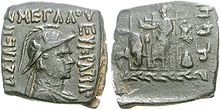Alexandria in the Caucasus
Alexandria on the Caucasus ( Alexandria ad Caucasum ) is a city founded by Alexander the Great in the Hindu Kush (the Hindu Kush was also called the Caucasus in ancient times ). The location of the ancient city is controversial, with research suggesting either Charikar or Gram .
The name is explained by the fact that the ancient Greeks called the Caucasus (Καύκασος) all mountain ranges that are located along and between the Black Sea , the Caspian Sea and the Aral Sea from the eastern Pontica to the Pamirs. (In the 19th century, the Kopet-dag was known as the Turkmen Caucasus and the Hindu Kush as the Afghan Caucasus).
According to Quintus Curtius Rufus , Alexander settled 7,000 Macedonians , 3,000 traders and thousands of locals there. Diodorus reports that the city was the gateway to India .
Alexandria in the Caucasus seems to have been one of the main places of the Indo-Greeks and is mentioned in the questions of King Milinda by King Menandros and in the Mahavamsa as a Greek city. In the Alexander novels she appears as the queen of the mountains .
In ancient sources it appears since the 5th century BC. An important city called Kapisa , which is also referred to as the capital of a kingdom in this region. Cyrus II is said to have destroyed this city according to later sources. The relationship between the two places is not clear. It has been suggested that Alexandria on the Caucasus and Kapisa were a twin city, or it is believed to be the same city that appears in ancient sources with two names. The problem here is that ancient writers locate both places in different places. However, this can also be explained by the fact that Alexandria on the Caucasus and Kapisa were a twin city that lay on both banks of a river, with each bank being assigned to a different region.
In Indo-Greek times, Kapisa had an elephant deity as the main deity, who was often represented like Zeus . She appears on coins from Eukratides I and is there explicitly referred to as the deity of Kapisa. The city became a summer residence under the Kushana rulers . Later it became part of the Sassanid Empire .
After the invasion of the Hephthalites , the city again became the capital of the small kingdom of the Nezak (see Iranian Huns ). Kapisa is still described in the seventh century AD by the Chinese traveler Xuanzang . He calls it Kapisi, capital of Kapisa. He stayed in the city for a summer and testifies to the survival of a cult around an elephant deity. At that time, the Turk-Shahi ruled in this area . Kapisa was very likely an important mint among the Indo-Greeks, Kushana, Sassanids and probably also among the Iranian Huns.
literature
- William W. Tarn: The Greeks in Bactria & India. 2nd Edition. Cambridge University Press, Cambridge 1951, pp. 460-462.
Remarks
- ^ Friedrik Hiebert, Pierre Cambon (Ed.): Afghanistan. Hidden Treasures from the National Museum, Kabul. National Geographic, Washington DC 2008, ISBN 978-1-4262-0295-7 , pp. 146-147.
- ↑ Strabo XI: 8.1
- ^ Curtius Rufus 7, 3, 23.
- ↑ Diodorus 17, 83.
- ↑ XXIX (there as Alasanda) .
- ^ Tarn: The Greeks in Bactria & India. 1951, p. 97.
- ↑ Pliny the Elder , Naturalis historia 6, 23
- ^ Tarn: The Greeks in Bactria & India. 1951, pp. 460-462.
- ^ So Tarn: The Greeks in Bactria & India. 1951, pp. 461-462.
- ↑ Madhukar K. Dhavalikar: Ganeśa: Myth and Reality. In: Robert L. Brown (Ed.): Ganesh. Studies of an Asian God. State University of New York Press, Albany NY 1991, ISBN 0-7914-0656-3 , pp. 49-68, here pp. 52-53.
